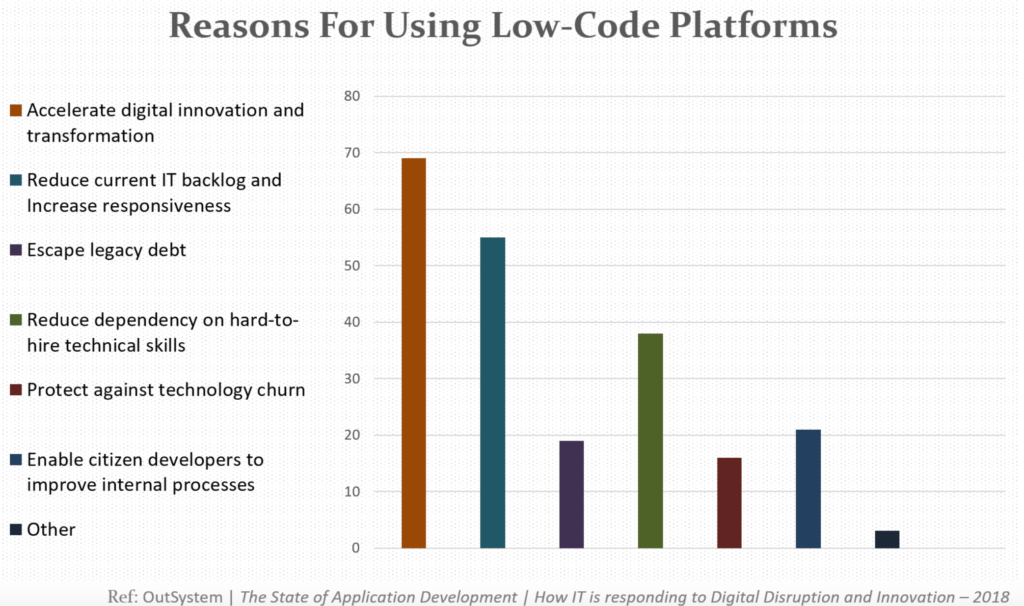
Contents:
- Low Code Application Platforms Introduction
- Definition of Low Code Application Platforms
- Reasons for Using Low Code Application Development
- Sample Enterprise Use Cases for Low Code
- Low Code Application Platform Features and Functionality
- Best Practices for Adopting a Low Code Development Practice
- Low Code Platform Vendor Evaluation Criteria
- Choosing the First Low Code Use Case
- Limitations and Shortcomings of Low Code Platforms
- Top Low Code Application Development Platforms
Low Code Application Platforms are a transformation technology for enterprises operating in the digital and cognitive era.
Low Code Application Platforms (LCAP) or Low-code Application Frameworks are all the rage in enterprise IT today. From hundreds of millions of dollars in venture capital funding to a hockey stick style growth, the low code revolution is here to stay.
Worldwide enterprises, the pandemic created a renewed sense of urgency for digital transformation, reshaping the ways we live, work, communicate, relate, and transact.
Given the burgeoning demand for software to drive every aspect of business, there is no way to educate, hire, train and deploy so many software engineers. There has to be an efficient and scalable way to develop and deploy a myriad of enterprise applications.
A low code application platform is one of the weapons in the IT arsenal to meet the business’s ever evolving and rapidly increasing software development needs. While a general citizen developer may not be adept, a technically savvy citizen developer may wield a low code toolset effectively.
Coding everything from scratch or relying on a multitude of SAAS solutions is sometimes not the right approach. Hence, a low code application framework is a strategic imperative.
Low Code versus No Code: A Clarification
Technically low code involves a bit of code whereas no code is completely code free and any citizen developer can do it. No Code platforms may work in certain specific situation including the last mile applications. At the end of this guide, we will list some No Code platforms – but how much is truly no code is up to you to determine. Furthermore, any No Code platform also will quality as low code, though.
Low Code Application Platform Definitions:
Before we go any further, let’s define what a Low Code Application Platform is:
Gartner’s Definition of Low Code Application Platforms: “An application platform that supports rapid application development, one-step deployment, execution and management using declarative, high-level programming abstractions, such as model-driven and metadata-based programming languages.”
Forrester’s Definition of Low Code Development Frameworks: “Application development platforms that enable rapid application delivery with minimal hand-coding, and quick setup and deployment.”
Transformation.Tech Definition of Low Code Platforms: “Low Code Application Development Platforms facilitate a visual assembly of basic building blocks to automatically generate code and compose an application, thus fostering rapid application development, deployment, and iterative refinement. Successful low code application platforms enable ease of use, flexible development environments, quick time to deployment, deliver high performance, and are cloud-native, transparent, secure, and scalable.”

Reasons for Using Low Code Application Development:
The Rising Tide of Digitalization: The need to embrace digital transformation is a core consideration for adopting a low code platform.
Scarcity of Talent: It is a classic high-demand situation and an ever-smaller supply of qualified IT developers. Along with reskilling and upskilling, a low code application development approach makes strategic sense.
Voracious Appetite for Software: The demand for new software has increased exponentially. According to IDC, over 500 million digital applications and services will be developed and deployed by 2023—the same number of apps that have been developed over the last 40 years.
Specialized Needs and Unique Niches: Each company is unique to some extent, which is the source of competitive advantage. So, instead of relying on one-size-fits-all SAAS applications or monolithic platforms where customization is cumbersome, costly, and time-consuming, building niche applications to cater to specific demands may be a worthy pursuit.
The following factors ranked high in a 2018 Survey by Outsystems.com on Reasons for Using Low Code Platforms:

Sample Enterprise Use Cases for Low Code:
Technically, one can develop any type of application using a low code application development platform.
For example, those enterprises that use Gartner’s pace-layered model, you can develop applications on all three aspects: Systems of Innovation | Systems of Differentiation | Systems of Record

Concept: Gartner
However, in general, companies are not building mission-critical transaction systems. Instead, the focus is on quick and simple development.
- Proofs of Concepts: Combining the fluidity of ease of use, UX, and weave together disparate pieces, companies can use low code to generate proofs of concepts. As the cost of failure is low, the risk of experimentation will also remain low.
- Prototypes: Sometimes, developers or the product managers themselves can create a visual and working prototype rather than static wireframes. This allows teams to touch and feel functionality – so to speak.
- Apps on New Platforms and Technologies: Whether IoT or Blockchain or AR/VR (Augmented Reality/Virtual Reality), the power of these technologies and platforms will come to the fore with a working application and a low code environment the burden of such endeavors.
- Integrations and APIs: Low code platforms are an excellent way to code integrations, APIs (Application programming interfaces), and fuse together functionalities for better business process orchestration.
- Dashboards: Low code platforms make it easy to connect data and develop dashboards for a multitude of enterprise users
- Portals: Instead of months on end development, assembling a portal with a slew of workflows and data is highly amenable to a low code environment.
Low Code Application Platform Features and Functionality:
Top 20 features, functions, and capabilities of Low Code Frameworks.
- Visual Development and Design
- Development Components and Elements
- Embedded UX
- One-time Development for Multiple Environments, Devices, and Form Factors
- Integration Interface Modeling
- In-built database
- Natively available Data Integration (not migration)
- Visual modeling and Assembly
- User Management and Role Modeling
- Template Library
- Standard Connectors
- The weaving of Workflows, Rules, and Conditionalities
- Process Orchestration
- Built-in Analytical Models
- Security
- Transparency, Traceability, and Governance
- Scalability
- Ease of Deployment
- High Performance
- Monitoring

Best Practices for Adopting a Low Code Development Practice:
Here are some best practices for making low code application platforms successful in an enterprise.
- Strategic Rationale: Establish a strategy and business case for why you need a low code platform. Just buying a low code platform because it is a shiny object or because the Joneses are doing so is not a sustainable proposition. Identifying the proper use cases, the process for intake and deployment of applications, establishing the appropriate governance, and determining the steady-state operational responsibilities are all a part of a strategic blueprint for onboarding a Low Code Practice
- Establish a COP (Community of Practice) (and forego a COE (Center of Excellence): Typically, enterprises tend to place any innovation in the center of Excellence that is typically aloof and away from the day-to-day business activities. Instead, let the business units and technology groups with the use cases drive the adoption. So, establishing a community of like-minded practitioners to share best practices and experiences from the trenches and co-develop and co-own reusable components will nurture the discipline.
- Conduct Workshops featuring cross-functional teams to envision what problems they will solve and what approaches they will embrace in pursuit of the low code platform adoption.
- Set up a Steering Committee for project approval and progress monitoring.
- Create a transparent and easy-to-follow governance mechanism.
- Identify metrics for success and measure them consistently.
- Fail Fast. Iterate Faster. And Refine Constantly.

Low Code Platform Vendor Evaluation Criteria:
Whenever there is a new paradigm, it is essential to develop a set of qualifying factors and evaluation criteria, and a low code platform is no different. Each enterprise is different, and the decision on what fits will depend on a variety of factors.
While Gartner’s Magic Quadrant or Forrester Wave for low code application platforms is a good starting point, that should not be the sole criterion. Instead, your use cases, company skillset, and trusted recommendations should be a part of your evaluation.
- Use Cases: The type of use cases and their type and complexity should be an essential driving factor for low code platform selection. Are these data-driven use cases? Or primarily UX-type use cases? Or Dashboards? Of course, in some enterprises, it could be all of the above.
- Skill Set: Who will be using the low code platforms? What are their skills and competencies? Are you looking for actual “citizen developers” to drive the platform? Or is it technically skilled who can accelerate time to market?
- Platform Components: What types of widgets, elements, components, connectors, templates, libraries, integration patterns, et al. come as a part of the low code or no-code platform?
- Proprietary or Standards-based: Will there be a vendor lock-in?
- Features and Functionality: The depth and breadth of features, capabilities, and functionality.
- Reusability: How much of the software and core components can be redeployed and reused in a different use case?
- Ease of Deployment: How effortless is it to go from development to production?
- Security: What level of security does the platform offer for the applications developed within?
- Scalability: Are the finished application Mickey Mouse apps, or can they be deployed at scale?
- Performance: What are the performance, fault tolerance, and failover standards?
- Cost: What is the total cost of ownership?
- Experience in your Industry Sector: What type of customers and use cases have the platform vendor solved in your industry/sector?
- Support and Services: What type of partnering and support services can the platform vendor provide?
- Stability of the Vendor: The financial strength and business viability of the vendor.
- Upgrades and Roadmap: what are the upgrade path and the roadmap items?
Choosing the First Low Code Use Case:
Now what you have acquired a shiny new low code application development platform, what use case should be the first? What factors and criteria should drive the selection of the first use case? Here are some ideas.
- Select a Use Case with High Value and High Visibility: Select a use case that helps shine a bright light on the low code platform without jeopardizing anything mission-critical.
- Ensure you have the right skills for achieving the use case: For example, if it is in the digital experience realm, do you have the right set of talent available? If it is a data-driven use case, do you have the right data talent? Or, if the use case involves machine learning, the right resources have the competency, capacity, and availability.
- Choose a Shorter Time Frame Use case: If you can deliver value within days or a couple of weeks, that would help chalk up the first win. On the other hand, anything that takes a dozen resources and six months is probably not a suitable first use case.
- Choose a Use Case that will Result in Reuse: Either at a component level or with an ability to recast and repurpose, if the first use case can help in reuse, that will showcase the low code approach in a bright light.
Limitations and Shortcomings of Low Code Platforms:
- Complex business logic and operations may stump low code development frameworks and platforms.
- Some applications built on low code may look good at a prototype stage, but some may not withstand the rigors of industrial-scale deployment.
- The WYSWYG (What you see is what you get) paradigm also will mean shortcomings and restrictions that will be difficult to overcome for advanced use cases.
- Learning Curve: Any new technology paradigm requires a certain period to get acclimated, which is true of the low code platforms.
- “Anyone can develop” with a low code platform is a myth and may lead to the underestimation of the technical skills necessary.
- The level of inbuilt security may not stand up to the needs of the modern enterprise with myriad security threats.
There is always some hype in every new technology, and enterprise business and technology leaders must discount some of the advertising and hoopla surrounding low code platforms.

